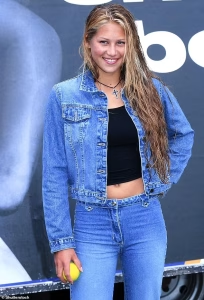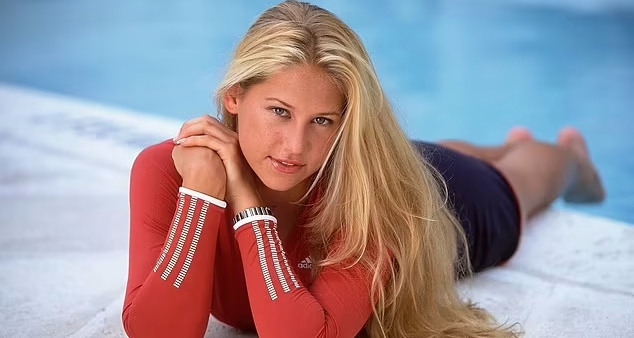At the height of her fame, she was one of the most photographed women in the world, a magnet for the paparazzi as well as for breathtakingly ignorant jibes about the perceived disparity between her looks and her talent.
Yet the pictures that surfaced this week of a wheelchair-bound Anna Kournikova in the affluent Miami coastal resort of Bal Harbour say more about the former tennis star than a thousand glossy photoshoots ever could.
They offer a poignant reminder of the injury struggles that forced Kournikova, who reached the Wimbledon semi-finals in 1997 and achieved a career-high ranking of No 8 in the world, to call time on her career aged 21.
The first photos of the reclusive 43-year-old to emerge in more than two years, which show her wearing an orthopaedic boot while accompanied by her two young daughters, also tell the story of a woman whose life has undergone a sea of change in the years since she departed the sporting stage.


They offer a portrait of the once teenage prodigy as a mother and also, by virtue of their very rarity, a nod to the more private, family centred life the reclusive Russian has enjoyed in the years since the flashbulbs faded.
Kournikova’s personal life, once the focus of endless media speculation – to the point where she famously told Sports Illustrated, ‘Every country I visit, I have a different boyfriend and I kiss them all’ – has long since ceased to be the subject of tabloid tittle-tattle.
The Russian has been in a relationship with the Spanish singer Enrique Iglesias since 2001, although the couple’s marital status – ‘We haven’t gotten married in public, but that doesn’t mean we are not married,’ Iglesias remarked cryptically two years ago – remains an enduring mystery.
Kournikova and Iglesias have three children, fraternal twins Lucy and Nicholas, aged seven, and five-year-old Mary. Lucy and Mary accompanied their mother in Bal Harbour, while the whole family were last pictured together in May 2022, when Kournikova posted a picture of Iglesias’s birthday celebrations on social media.

Kournikova’s desire for privacy, evident in the 16 ft walls that surround the family’s home, is not merely a reaction to an early life lived before the global gaze.
In 2005, two years after her retirement, she was targeted by a stalker, William Lepeska, who swam naked across Biscayne Bay towards her house in the hope that she would save him from drowning.
In the event, Lepeska, who was issued with a permanent restraining order requiring him to stay at least 1,000 ft away from Kournikova, swam to the wrong house.
‘I was absolutely shocked and fearful and I was very much concerned for my safety,’ said Kournikova, who hired bodyguards and ramped up security at her home following the incident.
‘It was very frightening and scary, just knowing there is someone out there who’s obsessive.’
Given the questionable manner in which she was portrayed during her teenage years – even Sports Illustrated dubbed her a ‘teen sexpot’ at the age of 16 – there was a depressing sense of inevitability about the incident.
By the time she was voted the world’s sexiest woman by the men’s lifestyle magazine FHM in 2002, Kournikova had already acquired notoriety by featuring in a sports bra ad that featured the tagline: ‘Only the ball should bounce.’
She even inspired a computer virus, with an e-mail attachment purporting to bear her image spreading like wildfire in early 2001, famously earning her a mention in the penultimate season of Friends the following year.
Yet the woeful manner in which she was portrayed did not prevent Kournikova from becoming the world’s highest-paid female athlete, and nor did it stop her from compiling a record that would be the envy of most players.
In addition to a top-ten ranking and a major semi-final, Kournikova twice won the Australian Open women’s doubles alongside fellow prodigy Martina Hingis, and was a fixture in the latter stages of grand slam doubles events in the late 90s and early noughties.
A quarter-finalist or better in women’s and mixed doubles at each of the four majors, she contested finals at the French Open, Wimbledon and the US Open and attained the world No 1 ranking in doubles in 1999.
Barely less significant was her influence on the generation of Russian players that followed her. Within a year of her retirement, Maria Sharapova, Svetlana Kuznetsova and Anastasia Myskina had all won grand slam titles, and in the years since Russian players have been a fixture at the top end of the sport.
Kuznetsova, a French and US Open champion and former world No 2, has no illusions about the extent of Kournikova’s influence, insisting that her compatriot was responsible for putting Russian tennis on the map.
‘She brought really big popularity to Russian tennis, women’s tennis,’ Kuznetsova said in 2017. ‘Everyone after her was just after her.
